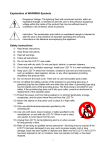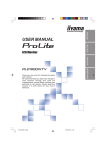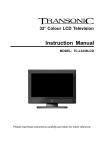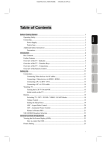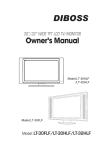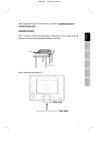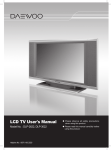Download Hanns.G JT01-32E2 32" Black LCD TV
Transcript
Explanation of WARNING Symbols Dangerous Voltage: The lightning flash with arrowhead symbol, within an equilateral triangle, is intended to alert the user to the presence dangerous voltage within the inside of the product that may be sufficient level to constitute a risk of electric shock to persons. Instruction: The exclamation point within an equilateral triangle is intended to alert the user to the presence of important operating and servicing instructions in the literature accompanying the appliance. Safety instructions 1) 2) 3) 4) 5) 6) 7) 8) 9) 10) 11) 12) 13) 14) 15) 16) Read these instructions. Keep these instructions. Heed all warnings. Follow all instructions. Do not use this LCD TV near water. Clean only with dry cloth. Do not use liquid, alcohol, or aerosol cleaners. Do not block any ventilation openings. Install your LCD TV in a well ventilated area. Keep your LCD TV away from moisture, excessive dust and any heat sources, such as radiators, heat registers, stoves, or any other apparatus (including amplifiers) that produce heat. Do not remove the back cover. There are no user-serviceable parts inside. Do not defeat the safety purpose of the polarized or grounding-type plug. A polarized plug has two blades with one wider than the other. A grounding type plug has two blades and a third grounding prong. The third prong is provided for your safety. If the provided plug does not fit into your outlet, consult an electrician for replacement of the obsolete outlet. Protect the power cord from being walked on or pinched particularly at plugs, receptacles, and the point where they exit from the LCD TV. Never rest objects on the power cord or place it in high traffic areas. Only use attachments/accessories specified by the manufacturer. Use only with stand, tripod, bracket, or table specified by the manufacturer, or sold with the LCD TV. When a cart is used, use caution to avoid injury from tip-over. Unplug this LCD TV during lightening storms or when unused for long periods of time. Refer all servicing to qualified service personnel-- Servicing may be required if the LCD TV has been damaged in any way, such as power-supply cord or plug damage, liquid has been spilled or objects have fallen into the LCD TV, the LCD TV has been exposed to rain or moisture, does not operate normally, or has been dropped. 1 17) Do not expose your LCD TV to dripping or splashing, and do not place objects filled with liquids on it. 18) The Shock Hazard Marking and Associated Graphical Symbol are provided on the back panel of unit. 19) This product is only to perform the useful function of entertainment and visual display tasks are excluded. 20) Wall or ceiling mounting: When mounting the product on a wall or ceiling, be sure to install the product according to the method recommended by the manufacturer. Use only the mounting hardware recommended by the manufacturer. This is a safety feature. CAUTION: Any damage caused by incorrectly attempting to mount this LCD TV is not covered under the terms of the manufacturers warranty. WARNING: To reduce the risk of fire or electric shock, do not expose this LCD TV to rain or moisture. Operation Instructions Thank you for purchasing multi-scan color LCD-TV. Please read this guide thoroughly before installation. HDMI Licensing Statement HDMI, the HDMI logo and High-Definition Multimedia Interface are trademarks or registered trademarks of HDMI Licensing LLC. CE Conformity for Europe The device complies with the requirements of the EEC directive 89/336/EEC as amended by 92/31/EEC and 93/68/EEC Art.5 with regard to “Electromagnetic compatibility”, and 73/23/EEC as amended by 93/68/EEC Art.13 with regard to “Safety.” Antenna Installation Instruction 1. Outdoor Antenna Grounding If an outside antenna or cable system is connected to the product be sure the antenna or cable system is grounded so as to provide some protection against voltage surges and built-up static charges, Article 810 of the National Electrical Code, ANSI/NFPA 70, provides information with regard to proper grounding of the mast and supporting structure, grounding of the lead-in wire to an antenna discharge unit, connection to grounding electrodes, and requirements for the grounding electrode. 2. Lightning For added protection for this product during a lightning storm, or when it is left unattended and unused for long periods of time, unplug it from the wall outlet and 2 disconnect the antenna or cable system. This will prevent damage to the product due to lightning and power-line surges. Do not disconnect the antenna or the power cord during a heavy storm lighting may strike while you are holding the cable cord, causing serious injury; turn off your LCD TV and wait for the weather to improve. 3. Power Lines An outside antenna system should not be located in the vicinity of overhead power lines or other electric light or power circuits, or where it can fall into such power lines or circuits, When installing an outside antenna system, extreme care should be taken to keep from touching such power lines or circuits as contact with them might be fatal. According to WEEE regulation , this monitor can't be handled as normal trash in Europe when it is out of usage. Please refer to the recycle information from our website to handle it. 3 Content ACCESSORIES...................................................................................................................1 FRONT PANEL BUTTONS ..................................................................................................2 INTERFACE.........................................................................................................................3 REMOTE CONTROL ...........................................................................................................4 INSTALLATION....................................................................................................................8 Connecting RF antenna or Cable TV Wire ...................................................................8 Connecting to External Stereo System to Listen to LCD TV Sound..............................8 Connecting to DVD/ Set Top Box..................................................................................8 Connecting to a computer...........................................................................................10 Connecting to a computer with HDMI-DVI cable ........................................................ 11 Connecting with the power cord.................................................................................. 11 BASIC OPERATION ..........................................................................................................12 Turning on the LCD TV ...............................................................................................12 Power On/Off ..............................................................................................................12 Select input source .....................................................................................................12 Volume Adjusting ........................................................................................................12 Channel Select ...........................................................................................................12 Sleep Time Setting......................................................................................................12 Sound .........................................................................................................................12 Video ..........................................................................................................................13 Using OSD Menu........................................................................................................13 ADVANCED OPERATION—OSD MENU/ REMOTE CONTROL.......................................14 Picture Menu ..............................................................................................................14 Sound Menu ...............................................................................................................14 Channel Menu ............................................................................................................15 Option Menu ...............................................................................................................17 PC Menu.....................................................................................................................17 OSD Menu..................................................................................................................18 TECHNICAL SPECIFICATION ..........................................................................................19 SAFETY PRECAUTIONS ..................................................................................................20 CARE AND MAINTENANCE .............................................................................................21 TROUBLESHOOTING.......................................................................................................21 4 ACCESSORIES Thank you for purchasing this LCD-TV. This LCD-TV package comes with: LCD TV User’s Manual Quick Start Guide Warranty Card Warranty and Service Manual Remote control Battery AA x 2 Power Cord VGA Cable 1 FRONT PANEL BUTTONS ❶ Volume - Down ❷ Volume + Up ❸ On Screen Display Menu On/Off ❹ Channel Down (Scroll Down) ❺ Channel Up (Scroll Up) ❻ Enter ❼ Power ON/OFF ❽ Remote Control Receiver ❾ Power LED Indicator 2 INTERFACE A B C D E F G H I J K L M N A Audio Output for AV, S-Video or YPbPr components (left/ right) B Audio Input for AV, S-Video or YPbPr/ HDMI-DVI components (left/ right) C Audio Input for VGA D RF Antenna / Cable TV Input E AC Power Switch (Must be turned on) F Power Input (AC Input) G HDMI1 Input Terminal (19 pin) H HDMI2 Input Terminal (19 pin) I VGA (15 pin) Signal Input from Computer J YPbPr/ HD Component Video Input K S-Video Input L Composite Video input M SCART 1 Input N SCART2 / SCART2-SV Input 3 REMOTE CONTROL 4 Remote control button function as follows: : 1 POWER Power ON/OFF 2 3 DUAL I / II INFO MTS (Multi-Channel TV Sound) select Display the current information 4 SLEEP Set TV Sleep timer 5 SOUND Select situation mode for sound 6 FREEZE Freeze picture 7 0~9 NUMBER Switch channel number keys 8 AVC 9 VOL UP/ DOWN The tuner contains automatic volume control circuitry (AVC) to prevent converter overload (for TV only) Adjust volume up or down 10 UP/ DOWN/ LEFT/ RIGHT/ ENTER UP/ DOWN/ LEFT/ RIGHT: Select or adjust the function of OSD ENTER: 1) Confirm the selection (in OSD menu) 2) Display Program List and select program channel (in TV mode only) 11 12 INPUT RED Input source select In Teletex function: move cursor down In Name function: edit channel name / select channel for exchange 13 GREEN 14 YELLOW 15 BLUE 16 MUTE 17 18 TV PICTURE In Teletex function: move cursor up In Name function: add desired channels / select channel for exchange In Teletex function: change from current page to selected page In Name function: erase desired channels In Teletex function: go out from CURSOR Mode In Name function: confirm edited name / confirm exchange Volume mute ON/OFF Direct to TV source 19 WIDE Select situation mode for picture Change aspect ratio 20 21 22 RETURN PROGRAM UP/ DOWN MENU Return to previous channel Select up or down programs OSD menu ON/OFF 23 TELETEXT FUNCTION CONTROL button Please refer to page 6-7 5 Teletext function control button TEXT/ MIX/ PICTURE button In TV Mode: Press the TEXT/ MIX/ PICTURE button to enter the Teletext mode. In TELETEXT Mode: Press the button again to superimpose a Teletext Broadcast onto the screen of current TV program (mixed Mode). In MIXED Mode: Press the button again to return back to the normal TV Screen (current program). SUBCODE button When a selected Teletext page with hidden sub pages or timed pages, these pages can be seen by the following manner: Press the sub code button. Screen will show « /0001 ». Enter 4 digits number button corresponding to the sub page desired. E.g. 0001 for sub page number 1. Wait until the page appears. STORE button Store current page in List mode. Press the LIST button to change from FLOF system to LIST Mode. Press a coloured button corresponding to the coloured brackets on the screen for page number storage. Enter the Teletext page number using the 0 ~ 9 digit buttons (enter three digits). Press the STORE button to memorize the page numbers you require. HOLD button Press this button to remove the information from the display and stop the automatic page change which will occur if a teletext page consists of 2 or more sub pages. To continue press this button again. The number of sub pages and the sub page displayed is, usually, shown on the screen below the time. When this button is pressed the stop symbol is displayed at the left-top corner of the screen and the automatic changing is inhibited. REVEAL button Press this button to display concealed information, such as solutions of riddles or puzzles. Press this button again to remove the information from the display. SIZE button Select double height text under Teletext mode for full screen. Press this button to enlarge the top half of the page. 6 Press this button again to enlarge the bottom half of the page. Press this button again to return to the normal display. LIST button Press this button you force the Teletext to LIST Mode. It means that row 24 (bottom row of Teletext) will not have transmitting information, only the pages that you have previously stored in the memory. Press LIST button again to exit from LIST Mode to Teletext. INDEX button Press the Index button to return back to index page. When you press this button in Teletext mode, a CURSOR appears. This cursor (rectangular box) contains a page number and you can select the desired page simply by using the four colours. RED button: Move cursor down. GREEN button: Move cursor up. YELLOW button: Change from current page to selected page. BLUE button: Exit the CURSOR Mode. 7 INSTALLATION Connecting RF antenna or Cable TV Wire Make sure the power is OFF before installing your LCD TV. Connect the LCD TV to TV antenna wire or cable/satellite box with 75-ohm coaxial cable. Preset the TV channels into memory with AUTO SCAN function (see page 15) when using an antenna or cable TV system without a cable connecter box. RF Cable or Adapter (not supplied) Connecting to External Stereo System to Listen to LCD TV Sound Connect the audio output terminal of the LCD TV to the audio in terminal of the stereo system (stereo system sold separately). When main source is selected to HDMI, audio output is not supported. Audio in Cable (not supplied) Stereo system Connecting to DVD/ Set Top Box Connect Video/ Audio cables from compatible devices into the back panel of LCD TV. 1) With RCA A/V cable VCD or DVD Player RCA A/V Cable (not supplied) 8 2) With S-Video cable: VCD or DVD Player Audio in Cable (not supplied) S-Video Cable (not supplied) 3) With YPbPr cable: YPbPr Cable (not supplied) VCD or DVD Player Audio in Cable (not supplied) 4) With SCART1: SCART Cable (not supplied) VCD or DVD Player 5) With SCART2/ SCART2-SV: SCART Cable (not supplied) Set top or DVD Player 9 Note: SCART1 SCART2 SCART2-SV Acceptable Signal AV/RGB AV S-Video Available Provided Input Source TV only CVBS signal SV signal 6) With HDMI cable: VCD or DVD Player (DVD Player should have the HDMI Output terminal) HDMI Cable (not supplied) 7) With HDMI to DVI cable: VCD or DVD Player (DVD Player should have the DVI Output terminal) Audio in Cable (not supplied) HDMI-DVI Cable (not supplied) Connecting to a computer Connect the VGA cable from VGA output of the computer to the VGA terminal input of your LCD TV. Also, connect the Audio In cable (green) from the audio output of your computer to the audio input terminal (green) of the LCD TV. PC PC Audio In Cable (not supplied) VGA 15 Pin Cable 10 Connecting to a computer with HDMI-DVI cable Connect the HDMI-DVI cable from the DVI output of the computer to the HDMI terminal input of the LCD TV. Also, connect the green end of the Audio In cable from the audio output of your computer to the audio input terminal (red/white) of the LCD TV. PC Audio In Cable (not supplied) HDMI-DVI Cable (not supplied) Connecting with the power cord Connect the power cord to the power cord connector on the back of your LCD TV, and plug the other end of the power cord into a correctly grounded electrical outlet. AC Switch Switch to ON AC power socket Power Cord 11 BASIC OPERATION To operate your LCD TV, you may use the TV remote control or upper panel buttons to select input source, change channels, or adjust volume. Turning on the LCD TV Before using the LCD TV: 1. Connect external equipments properly. 2. Insert the power cord. 3. Turn on Main Power Switch, located on the rear of the cabinet (If the LCD TV will not be used for a long period of time, please turn it off). Power On/Off To turn the LCD TV on/off : Press POWER button on the bottom of the cabinet or press POWER key on your remote control to turn on/off the TV. The power LED indicator lights when the LCD TV is on. Select input source Press INPUT key and use ◄► to select the required input source between PC, HDMI1, HDMI2, TV, YPbPr, AV, SVIDEO, SCART1, SCART2, and SCART2SV. To confirm the selection, press ENTER. Volume Adjusting Press VOL+/- to adjust volume. To turn off the sound, press MUTE. To restore volume, press MUTE again, or press VOL+/- directly. Channel Select Press number keys or PROG ▲▼ keys to select the desired channels. Ex: the desired channel is 8--Press 0 → press 8, or press 8 only. Return to the previous channel, press RETURN key. Sleep Time Setting Repeatedly press SLEEP key to set the off timer. The function is used to automatically shut off the LCD TV after a preset period of time passed. There are several times for choice -- 15min, 30min, 45min, and 60min. To cancel Sleep Time function, choose 0 min. Sound Sound Mode Select Repeatedly press SOUND to select the sound mode between User, Speech, Movie, and Music. MTS Select Press DUAL I/II key to set up MTS system. The function is to provide multi-channel TV sound. MTS can receive Dual, Stereo, SAP (Secondary Audio Program), or Mono sound. SAP feature permits the TV station to broadcast other information, such as audio in another language. With Dual sound, you can enjoy the main sound (normal program soundtrack) and the second language at the same time. **Choose the available sound output for channels that is preset by TV broadcasting station. 12 Program’s sound setting dual stereo mono Exchangeable sound output dual I, dual II stereo, mono mono Video Picture Mode Select Repeatedly press PICTURE key to select picture mode between User, Standard, Movie, and Vivid. Aspect Ratio Select Repeatedly press WIDE key to select image size between Full, Zoom1, Zoom2, Normal, Panorama, or WSS (auto format switching). Freeze Picture Press FREEZE key to freeze picture. However, the sound still continues. Using OSD Menu You are able to use On Screen Display (OSD) menus to adjust various settings by using your remote control or menu button on the top of the LCD TV. The basic operation is as following: Press MENU to display OSD menu. Press ▲▼ to select your desired top Menu. Press ◄► to enter the menu you select. Use ▲▼ to select the control you want to adjust. Press ◄► to adjust or select the settings. Press MENU again to exit the current OSD page. PS. In OSD page, if the item is with an arrow ►, it indicates that there is a sub-OSD page with it. You have to press ◄ or ► to get into sub-OSD page. However, if the item is with two arrows ◄(selection)►, it means that user may just press ◄► to select the selection. There is no sub-OSD page with it. 13 ADVANCED OPERATION—OSD MENU/ REMOTE CONTROL Picture Menu — Adjusting the picture It is active in TV/ AV/ S-VIDEO/ YPbPr/ SCART1/ SCART2/ SCART2SV/ HDMI1/ HDMI2 source. Contrast: To adjust contrast of video. Brightness: To adjust luminance of video. Colour: To adjust colour. Tint: To adjust tint level. Sharpness: To adjust picture sharpness. Fresh Tone: To adjust colour of skin. Colour Temp.: To select colour Temp. by pressing ◄►—warm redder, normal neutral, or cool bluer. Reset: Press ENTER to reset all the settings in Picture page. Sound Menu —To adjust sound It is active in all input sources. Bass: To adjust the bass (It is only active when sound mode is in “User” condition). Treble: To adjust the treble (it is only active when sound mode is in “User” condition). Balance: To adjust left and right audio balance. 14 Equalizer: To adjust the equalizer. Reset: Press ENTER to reset all the settings in Sound page. Channel Menu —To setup for TV It is only active in TV source. Auto Scan: To automatically preset the channels into TV’s memory. Select the country of your area with ◄► and then press ENTER to perform Auto Scan. If the country is not listed in the selection area, select “OTHERS.” Kindly suggest you auto scan all the channels before watching your TV for the first time. Note: After auto scanning all the channels, you need not to do it again when turning on your TV next time. Manual Store: To search the detectable channels and store them into memory manually. 1. Press ◄ or ► to get into “Manual Store.” 15 2. 3. 4. 5. 6. Move the cursor to “Prog. No, “ and select the desired channel position with ◄►. Move the cursor to “System,“ and select the system according to your local area with◄►. Move your cursor to “Search,” and search the detectable channels with ◄►. Move your cursor to “Fine Tune,” and adjust the picture with ◄►. Move to Store, then Store the instruction with ENTER. Note: The channel will be stored instead of the former program. Name: To enter a name for program with 0~9, +-. /, and A~Z. Press ◄ or ► to get into “Name.” 1. To enter a name: Press red key (on the remote control) to edit a name for the channel. Use ▲▼ to select the desired letter and use◄► to move the cursor to enter next letter. After the desired name is entered, press blue key (OK) to confirm. 2. To Erase/ Add channels: Use ▲▼ to select the desired channel. Press yellow key to erase the channel or press green key to add it. When using PROG▲▼ key, the channels you erased will be passed over. You may press green key to add the erased channels or use Auto Scan function to re-present them. 3. To exchange one channel with another: Press blue key to enter the function of “Sort,” and the following screen will show. If you want to exchange channel 1 with channel 2: 16 1. 2. 3. 4. Move your cursor to channel 1 and press red key (Sel1) to select channel 1. Move your cursor to channel 2 and press green key (Sel2) to select channel 2. Confirm your selection by pressing blue key (OK). Press MENU to exit. Option Menu When input source is PC/TV/ AV/ SV/YPbPr/ When input source is HDMI(PC), the controls /SCART1/ SCART2/ SCART2-SV/ HDMI(HDCP): of H-Position and V-Position are disabled: Main Source: To select the input source between TV, YPbPr, AV, S-Video, SCART1, SCART2, SCART2SV, PC, HDMI1 and HDMI2 with ◄►. H-Position: To adjust the horizontal position of the video with ◄►. V-Position: To adjust the vertical position of the video with ◄►. OSD Language: To select the OSD language between English, French, German, Spanish, Italian, Portuguese, Dutch, and Swedish with ◄►. TTX Language: To select the language of Teletext content. Reset: Press ENTER to reset all the settings in Option page. PC Menu —to Adjust for PC It is only active in PC and HDMI (support PC mode). When input source is PC: When input source is HDMI (PC), only the controls of Contrast, Brightness, Colour Mode, and Reset are active: Auto Adjust: To auto adjust picture’s horizontal position, vertical position, fine tune, and H-Size with ◄►. Contrast: To adjust foreground luminance of video. 17 Brightness: To adjust background luminance of video. H-Position: To adjust horizontal position of video. V-Position: To adjust vertical position of video. Clock: To adjust delay time of clock in order to reduce the noise of picture. Phase: To adjust delay time of phase in order to reduce the noise of picture. Colour Mode: To adjust colour temperature. 1. Press ◄ or ► to get into Colour Mode. 2. Use ◄►to select between Cool, sRGB, User, Normal, and Warm. 3. When “User” is selected, it allows you to adjust the colour of red, green, and blue separately. Reset: Press ENTER to reset all the settings in PC page. OSD Menu —To setup OSD window It is active in all input sources. H-Position: To adjust the OSD horizontal position with ◄►. V- Position: To adjust the OSD vertical position with ◄►. Duration: To automatically shut off the OSD after a preset period of time passed. Use ◄►to preset the time from 5 to 60 seconds. Reset: Press ENTER to reset all the settings in OSD page. 18 TECHNICAL SPECIFICATION LCD Type 31.51” TFT Active Matrix 0.51075(H) x 0.51075(V) mm pixel pitch Input signal Color Filter RGB vertical stripe Glass surface Anti-Glare RGB RGB analog (0.7/1.0 Vp-p, 75 ohms) Separate Sync, fh: 30-80 kHz, fv:50-75 Hz RF TV system Antenna / PAL Video 1 composite RCA, 1 S-Video, 1 YPbPr component, 2 HDMI, 2 SCART Audio 1 mini-stereo, 1 pair of RCA (L/R) stereo Compatibility PC Up to 1360 x 768 Non-interlaced Resolution Recommended and supported 1360 x 768 @ 60 Hz 1280 x 1024 @ 60 Hz, 75 Hz 1024 x 768 @ 60, 75 Hz 800 x 600 @ 60, 75 Hz 640 x 480 @ 60, 75 Hz Speaker Output 10W x 2 Audio Output 1 pair of RCA (L/R) stereo jack Power Voltage 100-240 VAC, 50/60 Hz (auto switch) Display area Full Scan 697.68 mm (H) x 392.25 mm (V) 27.5” (H) x 15.4” (V) Temperature 32°F to + 104°F ( 0°C to + 40°C) Humanity 20% to 65% (no condensation) Altitude To 10,000 feet (3,000m) Temperature -4°F to + 140°F (-20°C to + 60°C) Humanity 10% to 90% (no condensation) Altitude To 40,000 feet (12,000m) Physical 807.7mm (W) x 646.2mm (H) x 210mm (D) Operating conditions Storage condition Dimensions 31.8’’ (W) x 25.4’’ (H) x 8.3’’ (D) Weight Net CE, TÜV/GS Regulations Power saving modes 21.8 kg (48.0 Ib) On < 200 W (green LED) Active Off < 3 W (red LED) Preset Timing Mode (Pre-adjusted to GTF® 1360 x 768 @ 60 Hz) Warning: Do not set the graphics card in your computer to exceed these refresh rates; doing so may result in permanent damage to the LCD TV 19 SAFETY PRECAUTIONS This LCD TV is manufactured and tested to insure the user’s safety. Improper use or installation may result danger to the LCD TV as well as to the user. Carefully go over the following WARNINGS before installation and keep this guide handy. WARNINGS This LCD TV should be operated only at the correct power sources indicated on the label on the rear end of the LCD TV. If you’re unsure of the power supply in your residence, consult your local dealer or power company. Do not try to repair the LCD TV yourself as it contains no user-serviceable parts. The LCD TV should only be repaired by a qualified technician. Do not remove the LCD TV cabinet. There is high-voltage parts inside that may cause electric shock. even when the power cord is disconnected . Stop using the LCD TV if the cabinet is damaged. Have it checked by a service technician. Put your LCD TV only in a clean, dry environment. Unplug the LCD TV immediately if gets wet and consult your service technician. Always unplug the LCD TV before cleaning it. Clean the cabinet with a clean, dry cloth. Apply non-ammonia based cleaner onto the cloth, not directly onto the glass screen. Keep the LCD TV away from magnetic objects, motors, TV sets, and transformer. Do not place heavy objects on the cable or power cord. For PLUG CABLE EQUIPMENT, the Socket-outlet shall be installed near the equipment and shall be easily accessible. 20 CARE AND MAINTENANCE Care Avoid exposing your LCD TV directly to sunlight or other heat source. Place your LCD TV away from the sun to reduce glare. Put your LCD TV in a well ventilated area. Do not place anything heavy on top of your LCD TV. Make certain your LCD TV is installed in a clean and moisture-free area. Keep your LCD TV away from magnets, motors, transformers, speakers, and TV sets. Safety Tips If smoke, abnormal noise or odor came out of your LCD TV, caution should be remove the power cord immediately and call your service center. CAUTION-Never remove the rear cover of your LCD TV cabinet. The display unit inside contains high-voltage parts and may cause electric shock to human bodies. Never try to repair your LCD TV yourself. Always call your service center or a qualified technician to fix it. TROUBLESHOOTING No power Make sure A/C power cord is securely connected. Plug another electrical device into the power outlet to verify that the outlet is supplying proper voltage. Power on but no screen image Make sure the video cable supplied with the TV is tightly secured to the video output port on back of video source (DVD, VCR…). If not, tightly secure it. Adjust brightness. Make sure all signal cables are installed. Wrong or abnormal colors If any colors (red, green, blue) are missing, check the video cable to make sure it is securely connected. Loose or broken pins in the cable connector could cause an improper connection. Connect the TV unit to another video source or use another TVs to make sure the video source was not causing the problem. 21

























